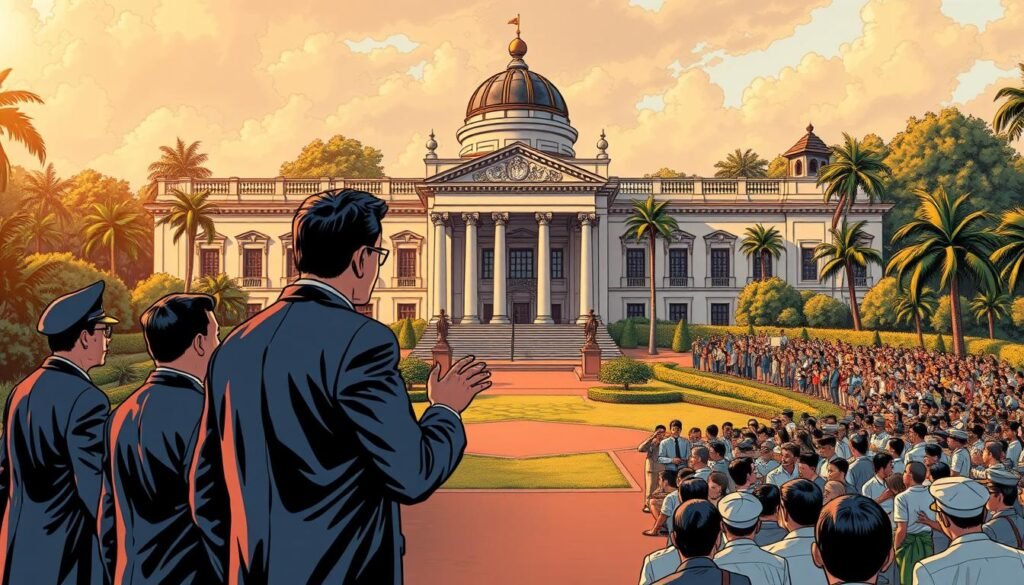The relationship between the United States and the Philippines has been shaped by a long history of political and cultural ties. From the colonial era to the present day, American influence has played a significant role in shaping Philippine politics. This influence is evident in various aspects, from governance to education and economic policies.
Understanding the dynamics of this relationship requires a look at both historical and contemporary factors. The Philippines’ political landscape has been influenced by American ideals, policies, and strategic interests. This has led to a unique blend of local and foreign elements in the country’s governance.
Social psychology offers valuable insights into how political behavior and persuasion work. Concepts like social influence and minority influence help explain how individuals and groups shape political outcomes. These psychological principles are crucial for understanding the complexities of Philippine politics.
This article will explore the historical foundations, psychological tactics, and real-world case studies of American influence in the Philippines. By examining these elements, we can better understand the interplay between cultural legacies and modern political strategies.
Key Takeaways
- American influence has significantly shaped Philippine politics over time.
- Historical and contemporary factors contribute to this influence.
- Social psychology helps explain political behavior and persuasion.
- The article will cover historical foundations, psychological tactics, and case studies.
- Understanding cultural legacies is key to modern political strategies.
Historical Foundations of American Political Involvement
The Philippines’ political framework has deep roots in its colonial past with the United States. During the early 20th century, the U.S. introduced governance structures that still shape the country today. This period marked the beginning of a unique blend of local and foreign political strategies.

Colonial Legacy and U.S. Political Strategies
The U.S. colonial administration aimed to establish a system of governance that reflected American ideals. They introduced public education, legal reforms, and democratic principles. These strategies were designed to create a foundation for self-governance while maintaining U.S. authority.
One key example is the establishment of the Philippine Assembly in 1907. This body allowed Filipinos to participate in governance, though under U.S. oversight. This approach demonstrated the use of social influence to encourage political participation while ensuring control.
Evolution of Governance and Lasting Impact
Over time, the U.S. shifted from direct colonial rule to more subtle forms of governance. The Tydings-McDuffie Act of 1934 paved the way for Philippine independence, but U.S. influence remained strong. Military agreements and economic ties ensured continued collaboration.
This transformation highlights the enduring impact of U.S. strategies. The Philippines adopted many American political practices, such as a presidential system and a bicameral legislature. These elements continue to shape the country’s political landscape today.
Harnessing Influence: Psychological and Social Tactics
Psychological tactics play a pivotal role in shaping political outcomes, especially in the context of Philippine politics. These strategies leverage principles like social proof and authority to craft persuasive messages that resonate with individuals and groups.

Understanding Social Proof and Authority in Politics
Social proof refers to the tendency of individuals to follow the actions of others, especially in uncertain situations. In politics, this can be seen when leaders highlight popular support for a policy to encourage others to adopt it. Authority, on the other hand, relies on the credibility of experts or leaders to sway public opinion.
Robert Cialdini’s research highlights how these principles can be used effectively. For example, citing the majority’s support for a policy can increase its acceptance. This tactic has been used in campaigns to reduce smoking rates and promote organ donation.
Comparing Minority and Majority Influence
While majority influence often leads to conformity, minority influence can drive lasting change. Minority groups can challenge prevailing norms and introduce new ideas. This process, known as minority influence, relies on consistency and commitment to persuade others.
Herbert Kelman’s studies show that minority influence is more likely to result in internalization, where individuals adopt new beliefs as their own. This contrasts with public compliance, where people conform without truly accepting the change.
Persuasion, Compliance, and Internalization
Persuasion involves changing attitudes or behaviors through communication. Compliance occurs when individuals publicly conform to a request, while internalization involves adopting the belief as part of their own value system.
In Philippine politics, these tactics are used to gain support for policies and campaigns. For instance, credible sources and expert endorsements can enhance the persuasive impact of a message. This approach builds trust and encourages lasting change.
How to Navigate and Leverage External Political Strategies
Navigating external political strategies requires a deep understanding of key actors and their roles. Whether you’re advocating for policy change or analyzing political dynamics, a structured approach is essential. This section provides a step-by-step guide to evaluating political actors and implementing effective advocacy strategies.

Step-by-Step Analysis of Key Political Actors
To navigate political strategies, start by identifying the key players. These include individuals, organizations, and groups with significant authority or social influence. Understanding their motivations and goals is crucial for effective engagement.
Here’s a framework for analyzing political actors:
- Identify Stakeholders: List all individuals and groups involved in the policy issue.
- Assess Influence: Determine their level of power and ability to sway public opinion.
- Evaluate Motivations: Understand their goals and what drives their actions.
- Map Relationships: Analyze how these actors interact and influence one another.
For example, in the Philippines, advocacy groups often collaborate with local leaders to amplify their message. This approach leverages social influence to build momentum for policy change.
Implementing Advocacy and Policy Change
Once you’ve analyzed the political landscape, the next step is to implement advocacy strategies. Effective advocacy relies on a combination of data-driven approaches and persuasive tactics.
Key methods include:
- Building Trust: Use credible sources and transparent communication to gain support.
- Leveraging Networks: Engage with influential individuals and organizations to amplify your message.
- Adapting Strategies: Tailor your approach to different stakeholder groups and political scenarios.
For instance, organizations with strong ethical cultures often experience fewer instances of misconduct. This highlights the importance of aligning advocacy efforts with core values.
| Strategy | Key Action | Example |
|---|---|---|
| Building Trust | Use credible sources | Partnering with local leaders in the Philippines |
| Leveraging Networks | Engage influential groups | Collaborating with advocacy organizations |
| Adapting Strategies | Tailor to stakeholders | Customizing messages for different audiences |
By following these steps, you can navigate the complex political landscape and achieve tangible results. For more insights, explore strategies for mitigating political risk.
Integrating Social Psychology with Political Strategy
The intersection of social psychology and political strategy reveals powerful tools for legislative innovation. By understanding how individuals and groups respond to social influence, political actors can craft strategies that drive meaningful change. This section explores real-world case studies where psychological principles have been applied to achieve significant policy breakthroughs.

Case Studies: From Social Influence to Legislative Innovations
One notable example is the use of social proof in environmental policy advocacy. In the Philippines, activists leveraged the principle of social proof by highlighting widespread public support for renewable energy initiatives. This approach not only increased public awareness but also pressured lawmakers to prioritize sustainable energy policies.
Another case study involves the application of authority in healthcare reform. By collaborating with respected medical professionals, advocates successfully influenced legislation to improve access to healthcare services. This strategy demonstrates how credibility can enhance the persuasive impact of a campaign.
These examples illustrate the practical application of social psychology in politics. By understanding behavior and persuasion, political actors can design strategies that resonate with their target audience. For more insights into the role of psychology in politics, explore political psychology.
Steps to Integrate Social Psychology into Political Strategy
To effectively integrate social psychology into political strategy, consider the following steps:
- Identify Key Behaviors: Determine the behaviors you want to influence, such as voting patterns or policy support.
- Leverage Social Proof: Highlight widespread support or successful examples to encourage adoption.
- Engage Credible Sources: Collaborate with experts or leaders to enhance the credibility of your message.
- Tailor Your Approach: Customize your strategy to align with the values and goals of your target audience.
By following these steps, political actors can harness the power of social psychology to achieve their goals. For instance, understanding the role of social identities can help reduce polarization and promote collaboration, as discussed in this study.
In conclusion, the integration of social psychology into political strategy offers a pathway to effective advocacy and policy change. By applying these principles, political actors can build trust, foster collaboration, and drive lasting impact.
Conclusion
The interplay of history, psychology, and politics offers a unique lens to understand the enduring American impact on Philippine governance. From colonial legacies to modern strategies, the influence of the U.S. has shaped the country’s political framework in profound ways.
Historical foundations, such as the introduction of democratic principles, continue to resonate in contemporary governance. Psychological tactics, like leveraging social proof and authority, provide practical tools for effective advocacy. Case studies highlight how these strategies drive meaningful policy changes.
Looking ahead, staying informed about these dynamics is crucial. The blend of historical context and psychological insights offers a roadmap for navigating complex political landscapes. For more on crafting impactful conclusions, explore this guide.
Understanding the role of behavior and group dynamics in politics can empower individuals and organizations to drive societal change. By integrating these insights, we can foster informed advocacy and strategic thinking in modern politics.
FAQ
How did American involvement shape Philippine politics historically?
The U.S. colonial legacy introduced governance structures and political strategies that continue to impact the Philippines. This includes the establishment of democratic institutions and the influence of American policies on local governance.
What role does social proof play in political strategies?
Social proof, a psychological tactic, leverages group behavior to sway public opinion. Politicians often use endorsements or public support to gain trust and credibility among voters.
How does minority influence differ from majority influence in politics?
Minority influence focuses on changing beliefs through consistent advocacy, while majority influence relies on widespread acceptance. Both tactics are used to shape public perception and policy outcomes.
What are the key steps to implementing advocacy and policy change?
Effective advocacy involves identifying key actors, building coalitions, and using persuasive tactics to drive policy shifts. It requires strategic planning and a deep understanding of the political landscape.
Can you provide examples of social psychology in political strategy?
Case studies show how social psychology principles, like authority and commitment, have been used to drive legislative innovations. For instance, campaigns leveraging trust and consistency often achieve long-term policy changes.
How do psychological tactics like persuasion and compliance work in politics?
Persuasion appeals to emotions and logic to change attitudes, while compliance focuses on gaining agreement through direct requests. Both are essential for influencing public behavior and decision-making.
Source Links
- Milestones in the History of U.S. Foreign Relations
- Philippines – US Influence, Colonialism, Revolution | Britannica
- U.S. Relations With the Philippines – United States Department of State
- Foundations of American Government [ushistory.org]
- United States – Founding Fathers, Constitution, Democracy | Britannica
- Foundations of U.S. Federalism
- Influence Tactics in Negotiation
- Social Proof and Influence: Harnessing Psychology for Effective Brand Marketing – Brand Spanking Marketing Agency
- Proven Strategies to Harness Social Influence for Increased Customer Sales | Beyond Philosophy
- Navigating the Currents of Corporate Politics: Leveraging Influence to Shape Strategy
- Social Influence and the Collective Dynamics of Opinion Formation
- Social Influence Theory – TheoryHub – Academic theories reviews for research and T&L
- Theoretical Integration (Part IV) – The Psychology of Social Influence
- Conclusion: Influence and Evidence in Reading-Related Policy
- Conclusion – Empire of Influence

